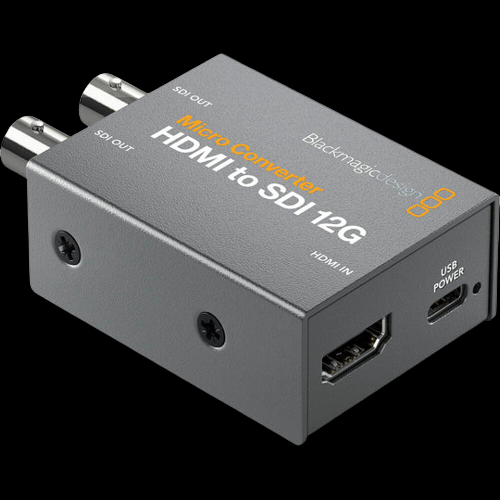A Comprehensive Guide to Blackmagic Micro Converters
In the fast-paced world of video production and broadcasting, versatility and adaptability are key. Blackmagic Design, a renowned industry leader, has introduced a family of compact yet powerful devices known as Micro Converters. These nifty gadgets bridge the gap between consumer-grade HDMI and professional SDI equipment, enabling seamless video signal conversion. In this in-depth guide, we will explore all the Blackmagic Micro Converter models, providing detailed insights into their features, applications, and technical specifications.
1: Unraveling Blackmagic Micro Converters
1.1 Understanding Blackmagic Micro Converters
- Introduction to Micro Converters
- Core features and benefits
- The significance of video signal conversion
1.2 Common Features Across All Models
- Compact design
- Powering options (USB and AC)
- High-quality connectors
- SDI re-clocking
- Support for diverse video standards
2: A Closer Look at Individual Micro Converter Models
2.1 Micro Converter SDI to HDMI 3G
Features and specifications
- Tailored for professional monitoring
- 3D LUT support for precise color calibration
- Supported video formats
2.2 Micro Converter HDMI to SDI 3G
Features and specifications
- Bridging HDMI cameras and computers to professional SDI setups
- Compatibility with various video formats
2.3 Micro Converter BiDirectional SDI/HDMI 3G
Features and specifications
- Bidirectional signal conversion capabilities
- Facilitating camera control protocol for seamless integration
2.4 Micro Converter SDI to HDMI 12G
Features and specifications
- Ideal for monitoring across SD, HD, 4K, and Ultra HD standards
- Advanced 33 point 3D LUT for precise color calibration
- Support for DCI film rates
2.5 Micro Converter HDMI to SDI 12G
Features and specifications
- Linking Ultra HD HDMI devices to professional 12G-SDI equipment
- Compatibility with various video formats
2.6 Micro Converter BiDirectional SDI/HDMI 12G
Features and specifications
- Advanced 12G-SDI bidirectional signal conversion
- Enabling camera control protocol for enhanced functionality
- In-depth exploration of the 3D LUT on SDI to HDMI
3: Applications and Use Cases of Micro Converters
3.1 Where Blackmagic Micro Converters Shine
- The incredible versatility of Micro Converters
- Applications in broadcast scenarios
- Crucial roles in live production setups
- On-set applications that simplify workflows
3.2 Real-World Examples of Micro Converter Applications
- Harnessing Micro Converters for color calibration
- Extending HDMI signals seamlessly using SDI
- Integrating HDMI cameras seamlessly into SDI setups
4: Technical Details and Advanced Features
4.1 Precision and Broadcast Quality
- Understanding the signal processing capabilities
- Delving into bit depth for enhanced video quality
- Mitigating SDI jitter for reliable long-distance transmission
- Supporting a wide range of video formats and frame rates
4.2 Update and Configuration
- Leveraging the converter utility for configuration
- Modifying converter settings for optimal performance
- Future-proofing through firmware updates
4.3 Monitoring with 3D LUTs
- Applying custom looks and color adjustments in real-time
- The versatility of Micro Converters in color calibration
- Creating and utilizing custom 3D LUTs with DaVinci Resolve
4.4 Embracing the Latest HDR Support
- Navigating the world of High Dynamic Range (HDR)
- Handling HDR formats with precision
- Supporting HDR static metadata PQ and HLG formats
- Embracing Rec.2020 and Rec.709 colorspaces
5: Camera Control and Timecode Support
5.1 Camera Control with Micro Converters
- Enhancing workflow with camera control
- Seamlessly integrating Blackmagic Pocket Cinema Cameras
- Translating camera control over SDI to HDMI
5.2 Timecode Support for Seamless Integration
- Full-timecode support in standard and high-definition video formats
- Converting HDMI timecode to SDI for synchronization
6: Accessories and Power Options
6.1 Powering Micro Converters: USB and AC
- The convenience of USB power
- Optional AC power supply for added flexibility
- International compatibility for global usage
6.2 Exploring Other Blackmagic Converters
- An overview of 3G-SDI, 6G-SDI, and 12G-SDI Mini Converters
- Additional features and use cases offered by these models
In conclusion, Blackmagic Micro Converters offer a compact yet powerful solution for video signal conversion, bridging the gap between consumer-grade HDMI and professional SDI equipment. These versatile devices come in various models, each tailored for specific applications. Whether you need precise color calibration with 3D LUTs, bidirectional signal conversion, or support for the latest HDR workflows, Blackmagic Micro Converters have you covered. Their compact design, high-quality connectors, and support for a wide range of video standards make them indispensable tools for video production.
The advantages and versatility of Blackmagic Micro Converters are evident in their ability to seamlessly integrate into diverse video production scenarios. They have transformed the industry by providing reliable, broadcast-quality conversion in a pocket-sized form factor. One of their standout features is their flexibility to adapt to evolving industry standards. With the ability to update firmware and add new television standards through software updates, Blackmagic Micro Converters ensure that your workflow remains up-to-date and future-proof.
In our final thoughts, it's clear that Blackmagic Micro Converters have had a transformative influence on the video production industry. Their compact size, broadcast-quality performance, and adaptability make them essential tools for professionals and enthusiasts alike. Whether you're in live production, broadcasting, or on-set shooting, these Micro Converters simplify complex signal conversion tasks, offering precision and reliability in a rapidly evolving technological landscape.





